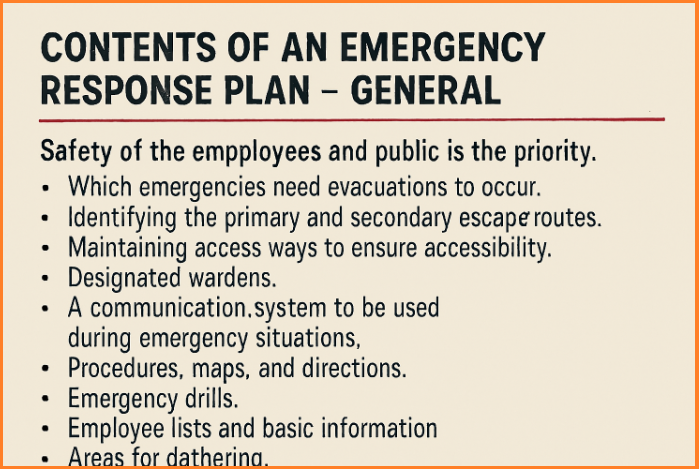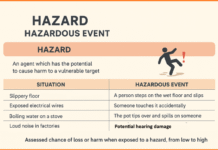An Emergency Response Plan (ERP) is a structured and strategic approach to ensuring the safety of employees, visitors, and the general public during unforeseen or hazardous situations. Whether in a workplace, industrial facility, school, or public area, having a well-prepared ERP is vital to minimize damage, prevent injuries, and potentially save lives.
Contents
Primary Objective: Safety First
The foremost priority of any ERP is the safety of employees and the public. A clear, organized, and well-communicated plan ensures that people respond quickly and effectively during emergencies such as fires, chemical spills, natural disasters, or security threats.
Key Contents of a General Emergency Response Plan
- Identification of Emergency Scenarios
The ERP should clearly outline which types of emergencies may require full or partial evacuation, such as:- Fire or explosion
- Hazardous material release
- Natural disasters (earthquakes, floods)
- Security threats or violence
- Escape Routes
- Clearly identify primary and secondary escape routes for all buildings or zones.
- Routes should be unobstructed and marked with visible signage.
- Access Ways and Maintenance
- Ensure hallways, exits, and stairwells remain clear and accessible at all times.
- Regular inspections should confirm accessibility of escape routes and emergency equipment.
- Designated Emergency Wardens
- Assign trained emergency wardens or floor leaders to assist in safe evacuation.
- Their duties may include guiding people, checking restrooms, and accounting for personnel.
- Communication System
- Establish a reliable communication system for emergency alerts and instructions (e.g., PA systems, alarms, SMS alerts).
- All employees must know how to report an emergency and receive updates.
- Emergency Procedures, Maps, and Directions
- ERP must contain step-by-step emergency procedures for various scenarios.
- Include floor maps, evacuation routes, fire extinguisher locations, and assembly points.
- Emergency Drills and Training
- Conduct regular emergency drills (at least annually) to test the effectiveness of the plan.
- Include training on roles, responsibilities, evacuation procedures, and use of emergency equipment.
- Employee Lists and Basic Information
- Maintain updated lists of all employees, including visitors or contractors.
- Keep basic contact and medical information confidential but accessible to emergency responders.
- Assembly and Gathering Areas
- Designate safe assembly points outside the building where employees can gather post-evacuation.
- These areas should be a safe distance from the building and away from potential hazards.
- Shelter-in-Place Guidelines
- For situations where evacuation is unsafe (e.g., toxic gas release), the plan should outline shelter-in-place procedures.
- Guidelines must include sealing the room, shutting off ventilation, and using communication tools to stay informed.
An effective Emergency Response Plan is not just a document—it’s a life-saving tool that prepares organizations to respond swiftly and smartly in times of crisis. By including all the essential components—such as escape routes, communication protocols, trained wardens, and clear procedures—organizations can significantly reduce risks and protect lives. Regular updates, employee involvement, and continuous training are key to making the ERP truly effective.





